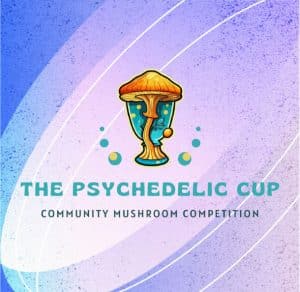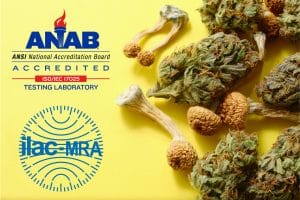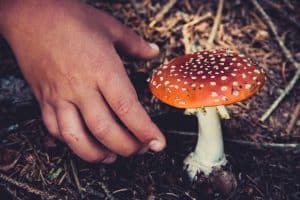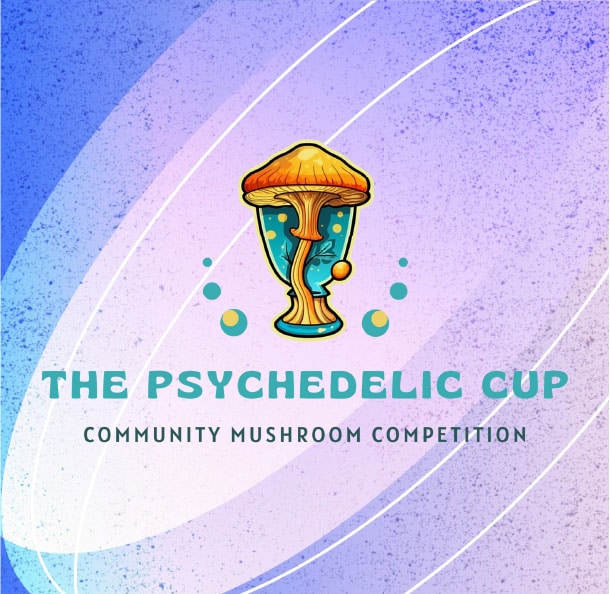Key Takeaways
- During our 11 week study, we saw decreases in psilocin pushing -35% and psilocybin pushing -15%, see graphs below.
- The loss of psilocybin appears to be both degradation, as well as conversion to psilocin, that then degrades as well.
- The compounds in psychedelic mushrooms are relatively unstable, so that chocolate bar in your fridge may not be as good as it used to be.
As you may know, psilocybin mushrooms are a type of fungi that contain the psychedelic compound psilocybin. These mushrooms have been used for centuries by indigenous people for religious and spiritual purposes.
In recent years, there has been a resurgence of interest in psilocybin mushrooms as a potential treatment for mental health conditions such as depression and anxiety.
While there is still much to learn about the effects of psilocybin on humans, some people who use these mushrooms regularly report that they lose their potency over time.
So, do psilocybin mushrooms lose potency?
Let’s take a closer look at what this compound is, current research, and our own study to provide further evidence.
So, what makes psilocybin mushrooms magic?
Magic mushrooms are a type of fungi that has piqued the interest of the scientific community for its unique psychedelic compound, psilocybin.
Found in certain species of mushroom, psilocybin is renowned for its psychoactive effects and its ability to produce intense visual and auditory hallucinations as well as profound changes in mood and consciousness.
Although psilocybin usage has far-reaching historical origins, a reemergence of interest in this remarkable substance can be noticed today due to growing research into its potential therapeutic benefits.
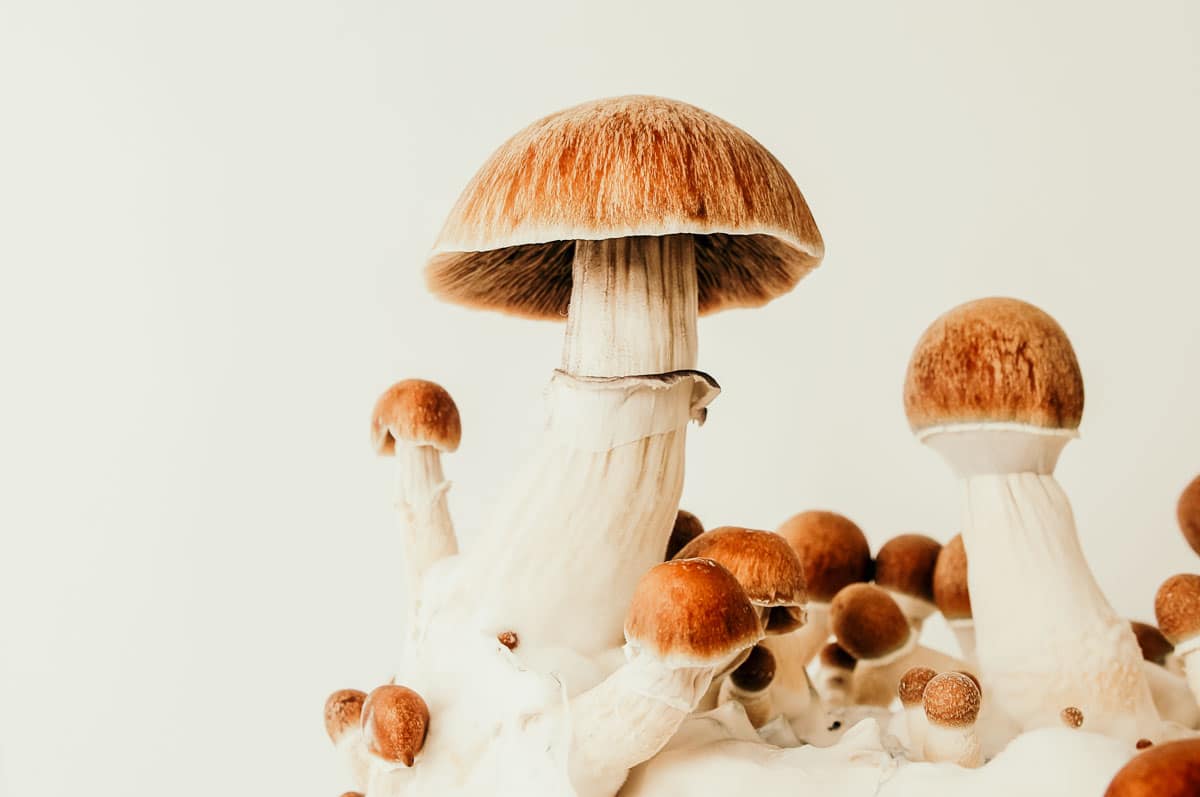
Therapeutic potential of psilocybin
Recent studies into the effects of psilocybin have highlighted potential therapeutic qualities in treating conditions such as depression and anxiety.
Researchers believe that by taking advantage of this natural compound, medical professionals could provide much needed relief to those suffering from these mental health issues.
Currently, further studies are being conducted to explore its mechanism of action and safety profile to determine if it can be used as an effective therapeutic drug. Of course, clinicians and users alike need to know if psilocybin will degrade over time and to what extent.
Previous Evidence: Psilocybin mushrooms lose potency
Recent studies have suggested that storage methods of psilocybin mushrooms may have an impact on the potency of the mushrooms.
Generally, storage in an airtight container in a cool, dry place away from light is advised to ensure that these fungi maintain their best quality and avoid losing their potency.
However, a study performed in April of 2020 at the University of Chemistry and Technology (Prague, Czech Republic) showed significant reduction of alkaloid concentration after one month of storage in the dark at room temperature1.
This means that storing them for longer periods of could result in a significant drop in concentration.
Our lab decided to set up a research study to test just this.
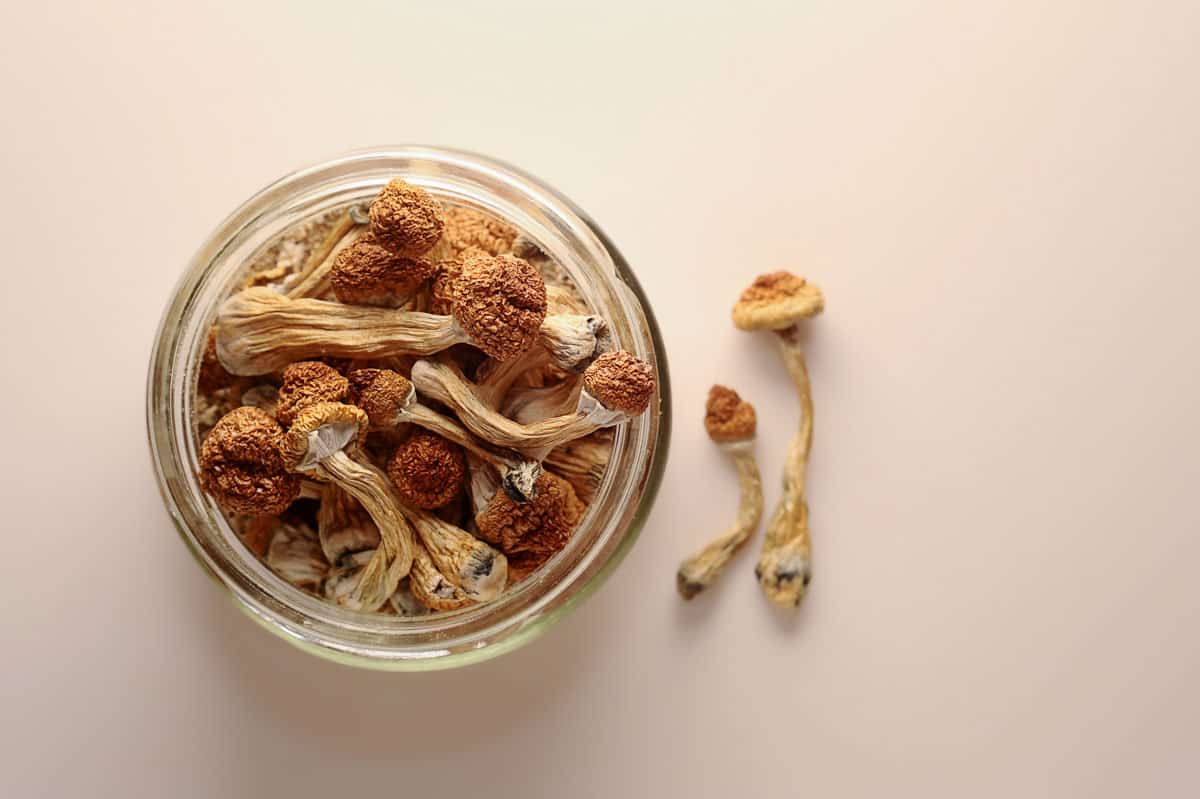
Our experiment’s results
Data accumulated was taken from the same sample of dried ground mushroom (species P. Cubensis) received on Nov. 29th, 2022. All results were averaged over multiple runs (N≥5). Extractions and analysis were completed over several weeks. The retain was kept at room temperature away from UV light (temperature monitoring verified ambient temperature never exceeded 20°C). The calculations were treated as significantly different if the change in results was greater than the calculated measurement uncertainty of +/- 3% for each compound. Also note that degradation calculations are relative to the original analysis.
The starting concentrations (%) were as follows:
- Baeocystin = 0.02%
- Psilocybin = 0.644%
- Psilocin = 0.102%
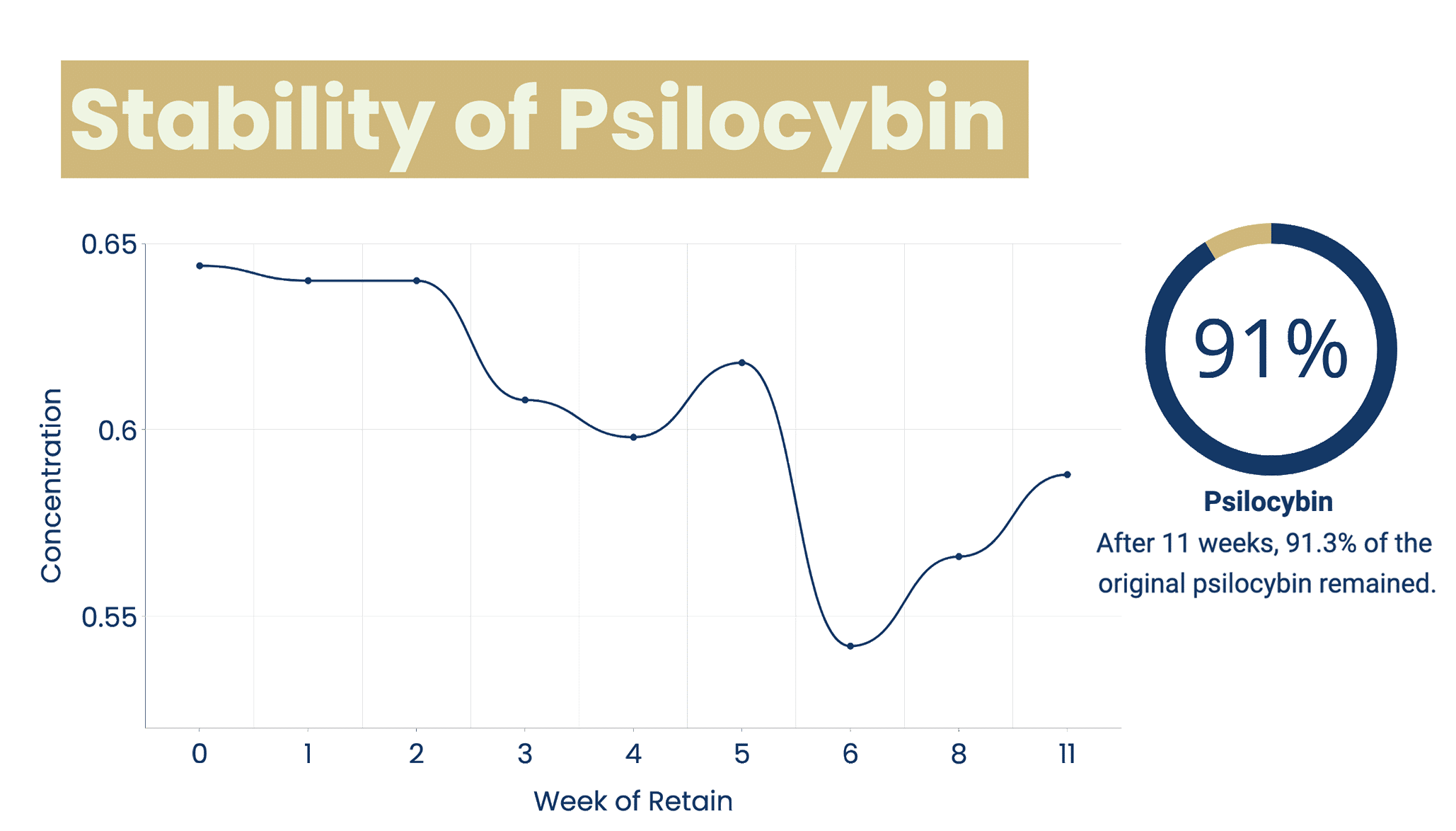
After one week of sample retain there was a 10% reduction in the psilocin concentration.
After two weeks of sample retain, there was a 5% reduction in psilocybin and a total reduction of 12% in psilocin.
The third week of data was some of the most interesting. Baeocystin had a 20% reduction in concentration while psilocybin did not incur any further changes. However, the psilocin concentration increased slightly (4% increase from the previous week). It is theorized that other compounds found in the sample could have degraded or converted into psilocin to cause this change.
After week four and five of sample retain, there was a total of 52% reduction in baeocystin, a total of 7% reduction in psilocybin, and a total of 29% reduction in psilocin.
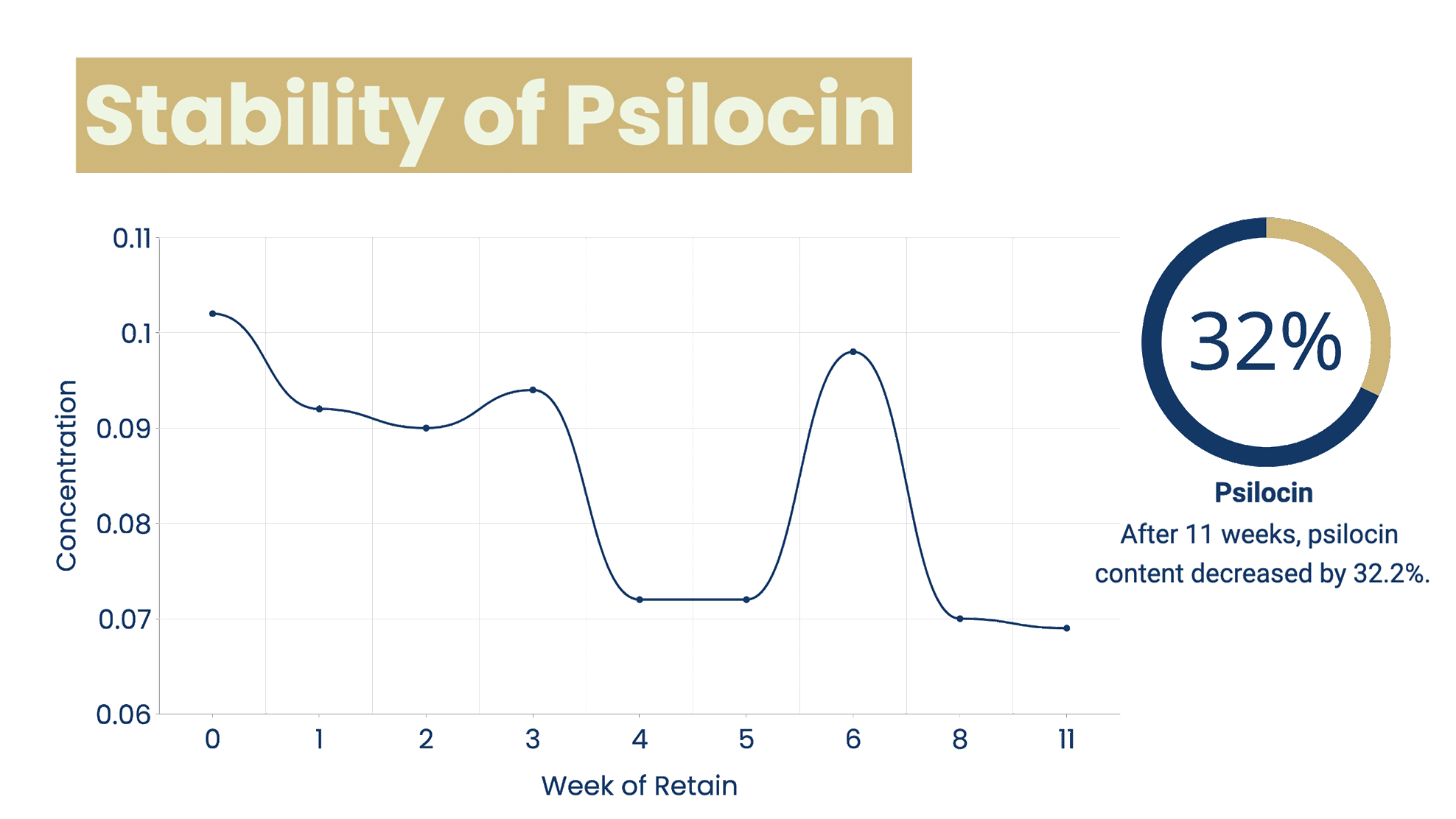
Week six marked a turning point in our study as baeocystin was now not detected above our limit of detection (LOD<0.007%) and the psilocybin concentration decreased by 15% compared with the original analysis.
Additionally, the psilocin concentration now only differed by 4% from the original analysis, although the prior weeks showed significant reduction. This increase of psilocin week over week likely can be attributed to the conversion of psilocybin to psilocin.

The results of our study mirror what was found in the study performed at the University of Chemistry and Technology (Prague, Czech Republic) and are summarized in figures 1-3.
Study Update (03/10/23)
Graphs have been updated to reflect new data.
As was noted in previous statements, the amount of psilocin had increased substantially from weeks five to six (roughly 26% increase). This was hypothesized as a product of psilocybin dephosphorylation occurring within the sample retain.
The reason for this hypothesis stems from the theoretical conversion yield of psilocybin to psilocin which is equal to about 67-72%. For example, if there was a known 100mg sample of pure psilocybin the theoretical yield of psilocin from this sample would be 100mg*0.72 (high side) = 72mg psilocin.
50% Off
1st Shroom Potency Test
Get the potency of your shrooms in 3 days flat.
Accurate Dosing
Anonymous
Improved Grows
Subscribe to get your code & learn more!
The theoretical conversion is due to the difference in the molecular weights of psilocybin and psilocin. In short, psilocybin’s chemical structure contains a phosphate group while psilocin is the same structure without the phosphate group (see below). This is also why psilocin is active and psilocybin is not.
This process is called dephosphorylation and is a naturally occurring, enzyme-mediated reaction. Dephosphorylation also can occur spontaneously, in the absence of enzymes, which is more than likely what we are observing here. Accounting for this difference in molecular weight, you can only yield about 72% psilocin from any amount of psilocybin. Below is the calculation:
Back to our hypothesis of why there was a large increase in psilocin from weeks five to six;
Our data show that we lost 0.076% of psilocybin from week five to six, therefore based on our theoretical yield we can calculate the expected increase of psilocin assuming our hypothesis is correct.
So, from week five to week six, the theoretical increase in psilocin is 0.055%.
Going back to the data, at week five there was 0.072% of psilocin, so adding 0.055% theoretical increase gives us a theoretical value of 0.127% psilocin at week six. The actual value found at week six was 0.098% which is slightly lower, however we must acknowledge that psilocin is still naturally degrading on its own!
Based on the available data and the theoretical conversion of psilocybin to psilocin it is reasonable to assume the increase of psilocin from week five to six was due to natural dephosphorylation occurring within the sample.
Furthermore, the eight week retention data showed no further decrease in psilocybin concentration (slight increase was within the margin of error), but the psilocin concentration plummeted 29%. Updated graphs that reflect this data are shown above.
We have also attached the raw data collected for this study below. We are continuing to monitor this study and eager to show our findings. Stay tuned for more updates.
Additional research is needed; we’re on it.
Recent storage-method studies for psilocybin mushrooms including our own have suggested that their potency can diminish over time.
Our internal laboratory study suggests there is considerable degradation of psilocybin after one month of storage in recommended conditions.
However, more research and analysis are needed to gain a better understanding of how storage methods and environmental conditions may affect the potency of psilocybin mushrooms. Until then, general storage-method recommendations should be followed.
Considering taking psilocybin shrooms? Know these risks.
It’s important to understand the implications associated with taking psilocybin mushrooms if you’re thinking about experimenting with them. As with any kind of drug, there are potential risks that one should be aware of before deciding whether the opportunity is worth it.

Reports show that psilocybin mushrooms can trigger bouts of anxiousness and confusion, so it’s best to have a trusted support system to turn to if needed.
It’s also recommended that those considering engaging in this kind of activity educate themselves on proper dosage, as well as how to create a safe environment for their experience.
Finally, commit yourself to knowing the law – in many places, possession or consumption of these mushrooms may be illegal depending on your jurisdiction. Taking the precautions and gaining enough knowledge should help ensure an overall positive experience.
While there is some evidence to suggest that psilocybin mushrooms may lose potency over time, there is no definitive research on this topic and more studies are needed.
Our research showed that not only do they lose potency, but just how quickly that occurs. However, because this is science, this is not a be-all-end-all answer.
In other words, if your mushrooms are 6 weeks old, you cannot simply blindly apply our data to your mushrooms. That being said, our data can and should be used as a guide.
If you’re considering taking psilocybin mushrooms, it’s important to do your research and be aware of the potential risks involved.
Store mushrooms in a cool dark place and get them retested before consuming them.
50% OFF First
Shroom Potency Test
Get the potency of your shrooms in 3 days flat.
Accurate Dosing
Never worry if you're taking the right dose again.
Perfect for microdosing!
Anonymous
Our testing process is confidential and allows you to remain anonymous if you want to.
Improved Grows
Quickly know how the changes you are making are impacting your mushroom's potency.
Subscribe to receive your code and learn more!
this article
-
12/07/22
Data collection began
-
02/01/23
Began writing article
-
02/13/23
Article reviewed
-
02/15/23
Article published
-
03/10/23
Article updated:
Data added for weeks 7-11

